Severe Weather Alert: Tornado Watch Issued in Minnesota
The National Weather Service has issued a tornado watch for multiple counties across western Minnesota, as severe storms are anticipated to develop this evening. Weather officials are warning residents to prepare for conditions that could spawn tornadoes, produce large hail, and deliver damaging winds.
What to Expect from the Storm
According to meteorologists, a potent weather system is pushing into Minnesota, bringing with it the potential for severe thunderstorms. The main threats associated with these storms include:
- Tornadoes: The atmospheric conditions are aligned to create supercell thunderstorms, which are capable of producing tornadoes. Residents are urged to remain vigilant as storms develop later in the day.
- Large Hail: Hailstones larger than an inch in diameter may fall, leading to significant property damage, particularly to vehicles and crops.
- Damaging Winds: Wind gusts could exceed 60 miles per hour, posing a threat to trees, power lines, and structures.
Immediate Actions and Precautions
As the severe weather system approaches, local authorities and meteorologists are advising communities to take necessary precautions:
- Stay Informed: Keep abreast of the latest weather updates. Use a NOAA weather radio, or download weather apps to receive real-time warnings.
- Create a Safety Plan: Make sure your family knows what to do in the event of a tornado warning. Identify a safe area in your home, such as a basement or interior room on the lowest floor.
- Secure Outdoor Items: Strong winds can turn unsecured items into projectiles. Bring in or secure patio furniture, decorations, and other lightweight objects.
Impact on Community Activities
The approaching storms have prompted many schools in the area to cancel afternoon activities. Parents are advised to stay alert to any further announcements regarding school closures or changes in schedules.
Weather History in Minnesota
Severe thunderstorms and tornadoes are not uncommon in Minnesota, particularly during the spring and summer months. Historically, the state has experienced numerous severe weather events that have caused significant damage.
- In May 2019, a series of tornadoes touched down in the southern part of the state, causing substantial destruction to homes and infrastructure.
- Earlier this year, in June 2023, Minnesota faced another outbreak of severe weather that resulted in tornado warnings across several counties.
How to Stay Safe During Severe Weather
Severe weather preparedness can be the difference between safety and disaster. Fortunately, there are simple steps you can take to ensure your safety and the safety of loved ones:
- Listen to Warnings: When a tornado watch is issued, you should be aware that conditions are favorable for tornadoes. When a tornado warning is issued, take immediate action to seek shelter.
- Prepare an Emergency Kit: Having an emergency kit with essentials such as water, non-perishable food, medications, flashlight, batteries, and a first-aid kit can be beneficial in case of power outages or if you need to shelter for an extended period.
- Practice Your Plan: Conduct regular drills with your family to ensure that everyone knows how to respond in case of severe weather.
Future Weather Predictions
Looking ahead, meteorologists predict that the severe weather threat will continue into the night, particularly as storms may develop and intensify as they move eastward across the state. It is essential to remain alert and prepared even after the initial storms pass, as conditions may change rapidly.
Local Resources and Support
In addition to staying informed through weather reports, residents can access local resources for assistance during severe weather events. Local emergency management agencies can provide information on shelters, emergency response plans, and resources available to individuals affected by severe weather.
- Red Cross: The American Red Cross offers emergency assistance and resources for those in need. Their mobile app can alert communities about severe weather and help create emergency plans.
- Community Centers: Local community centers may serve as emergency shelters during severe weather events. Check with your community to learn more about available resources.
Conclusion
As severe storms approach, it is essential to remain informed and proactive in ensuring safety. Continue to monitor the weather situation, heed warnings, and take necessary precautions. Together, we can navigate through this storm safely.







